The last differentiation operation in the course is something called
divergence, or, more briefly, div.
A tiny bit of review ...
Remember that if we start with a function, f, and if
∇=(∂/∂x)i+(∂/∂y)j+(∂/∂z)k,
then grad f is a vector field,
(∂f/∂x)i+(∂f/∂y)j+(∂f/∂z)k.
If F=Pi+Qj+Rk is a vector field then
curl F is ∇xF. Note that this is
(Qz-Ry)i-(Pz-Rx)j+(Py-Qx)k.
This is horrible, and difficult to remember but the notation
(especially the cross product and ∇) is designed to help!
Suppose we ∂/∂x the i component, ∂/∂y the
j component, and ∂/∂z the k component. Here in
this 21st century (!) math course, I seem to just be doing
this for fun. The people who actually invented these results had the
computations forced on them (really!) because they wanted
descriptions of certain aspects of reality involving fluid flow and
electromagnetism. These are the three results we get for the
differentiations:
(Qzx-Ryx) (Pzy-Rxy) (Pyz-Qxz).
I wrote these on the board, in a vertical way, and asked people to
look at them. A number of students observed that if we added them, the
result would be 0! This is weird and wonderful (a phrase which might
be used either positively or negatively about many parts of this
course). Our conclusion is that a vector field G for which
∇·G is not 0 cannot be the curl of another
vector field. This is a "compatibility condition" for being a curl.
Example (from a textbook problem attempted last night)
The vector field <0,0,z2> is not the curl of
another vector field, because 0+0+2z is not always 0.
Divergence
The divergence of a vector field F is
F=Pi+Qj+Rk is a function,
∇·F=∂P/∂x+∂Q/∂y+∂R/∂z.
It is also called div F. In fluid dynamics, this quantity
at a point sort of represents the source rate of the fluid
(more fluid if positive, less fluid if negative).
Statement of the Divergence Theorem
Suppose E is a solid bounded region in space (R3) and S is
the boundary of E, with N the outward pointing normal on
S. Suppose also that F is a vector field with differentiable
coefficients. Then:
∫∫SF·N dS=∫∫∫Ediv F dV.
The ingredients
Here S divides up space, R3, into two pieces (examples
follow). One of the pieces is a bounded region, E. The surface S is
always oriented in this "scenario" to have its N pointing
outward, away from the bounded region E.
The vector field, F(x,y,z), should be
P(x,y,z)i+Q(x,y,z)j+R(x,y,z)k and P, Q, and R
should be differentiable functions. The divergence of F is
∇·F:
(∂P/∂x)+(∂Q/∂y)+(∂R/∂z).
Simple examples of regions and surfaces
| Most "concrete" computations with the Divergence
Theorem will likely involve fairly simple shapes. |
- The sphere
Here the spatial region is the inside of a sphere (a ball). The
surface is the sphere, and the normals, a few of which are shown,
point outward from the center of the sphere.
- A parallelopiped
This is supposed to be an object with six flat sides, with the
opposite sides parallel in pairs. The surface has exactly 6 outward
normal vectors, one for each side.
- A torus
The region in space is the region inside a torus. The surface has
normals pointing out, but now the surface is more complicated. Indeed
there are even some normals which point at each other!
|
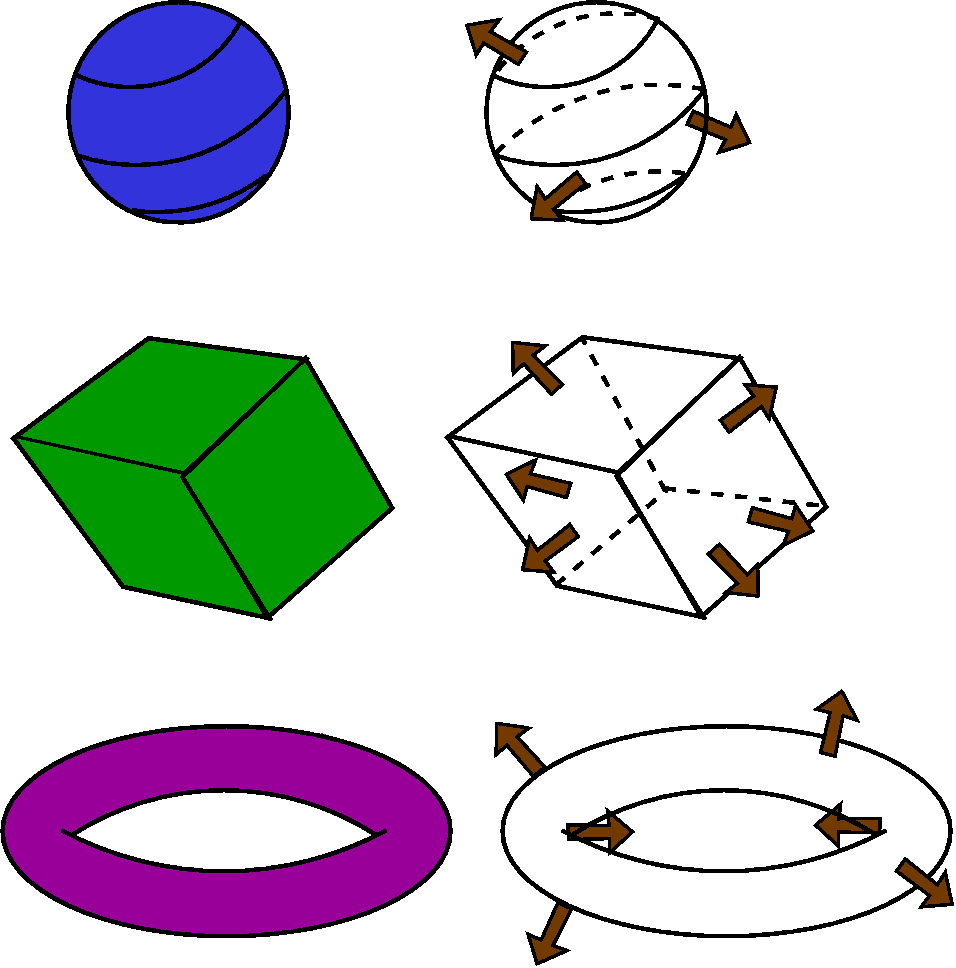
|
Fluids and the Divergence Theorem equation
The equation ∫∫SF·N dS=∫∫∫Ediv F dV
itself has meaning in fluid dynamics. The right-hand side is the net
flow(flux) in/out of the cube (in fact, such a cube is commonly called
a flow box in that field). The left-hand side is the triple
integral of the local source rate of the fluid flow.
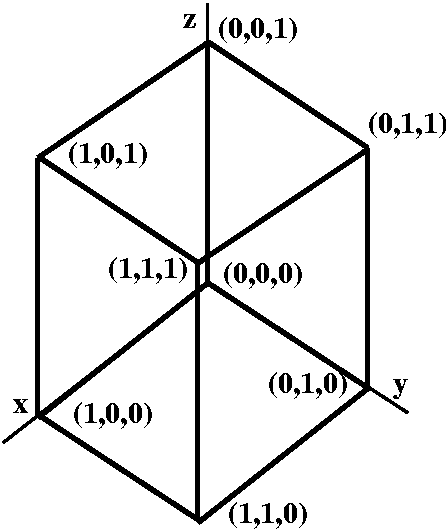 Proving the Divergence Theorem for the unit cube
Proving the Divergence Theorem for the unit cube
I wanted to "demystify" the Divergence Theorem by explaining why it is
true for the unit cube in R3.
The unit cube is a parallelopiped whose vertices (corners) have
entries 0 or 1. There are 8 vertices: (0,0,0), (1,0,0), (0,1,0),
(0,0,1), (1,1,0), (1,0,1), (0,1,1), and (1,1,1). There are 12
edges. Edges join at two vertices whose coordinates differ by one
entry. There are 6 faces, each obtained by holding one coordinate
equal either to 0 or to 1. By the way, the unit cube and its
generalizations in higher dimensions turn out to be very
interesting. One reason is the existence of Gray codes.
Now the triple integral side of the Divergence Theorem is
∫∫∫The cube(∂P/∂x)+(∂Q/∂y)+(∂R/∂z) dV. I will
split this into three separate integrals, and analyze each part.
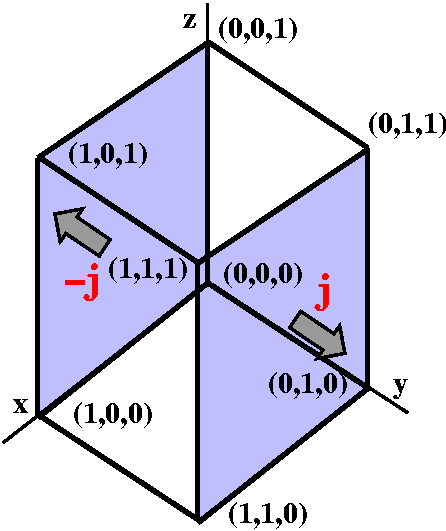 Following the suggestion of Mr. Forrest, we looked at
∫∫∫The cube(∂Q/∂y) dV.
We decided to write dV here as dy dAx,z. The
reason for this is that the integration with respect to y will
"undo" the ∂/∂y.
Following the suggestion of Mr. Forrest, we looked at
∫∫∫The cube(∂Q/∂y) dV.
We decided to write dV here as dy dAx,z. The
reason for this is that the integration with respect to y will
"undo" the ∂/∂y.
The innermost integral is then
∫y=0y=1(∂Q/∂y) dy. The Fundamental Theorem of Calculus immediately applies and we get Q(x,y,z)]y=0y=1=Q(x,1,z)-Q(x,0,z). We then integrate both of these:
∫∫x,z between 0&1Q(x,1,z) dAx,z-∫∫x,z between 0&1Q(x,0,z) dAx,z
Now look at the surface. The (x,1,z) part of the surface integral has
j as normal, and the (x,0,z) part of the surface has -j
as normal. The surface integral of F·n will be -Q(x,0,z) and will be
+Q(x,1,z). In both cases, x and z will range from 0 to 1. The
Fundamental Theorem of Calculus yields a minus sign when "stuff" is at
the lower end of the integral. Geometrically, we get a minus sign on
part of the boundary because the normals are directed outward.
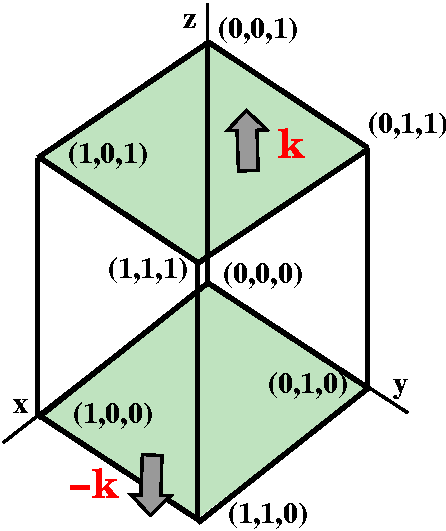
Let's look at ∫∫∫The cube(∂R/∂z) dV. I would write dV as dz dAx,y. The
Fundamental Theorem of Calculus would apply to the innermost
integral:
∫z=0z=1(∂R/∂z) dz=Q(x,y,z)]z=0z=1=Q(x,y,1)-Q(x,y,0). Again
integrate both of these:
∫∫x,y between 0&1Q(x,y,1) dAx,y-∫∫x,y between 0&1Q(x,y,0) dAx,z
The minus sign comes from the Fundamental Theorem of Calculus and it comes from the +/-orientation of the normals.
Finally the last term is ∫∫∫The cube(∂P/∂x) dV. I hope that you see dV here should be written as
dx dAy,z. Then the Fundamental Theorem of Calculus
applies and we've got this:
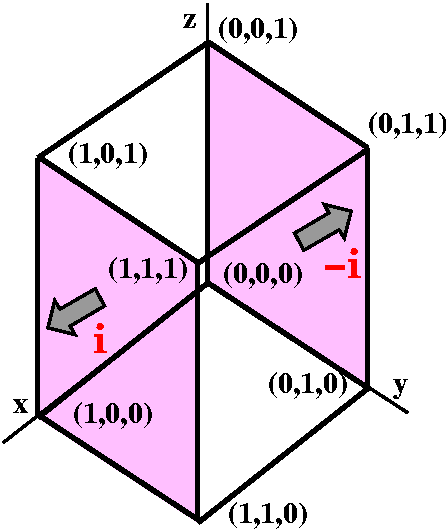 ∫x=0x=1(∂P/∂x) dx=P(x,y,z)]x=0x=1=P(1,y,z)-Q(1,y,z).
∫x=0x=1(∂P/∂x) dx=P(x,y,z)]x=0x=1=P(1,y,z)-Q(1,y,z).
Each of these terms needs to be integrated with respect to y and z
from 0 to 1. The + part (that is, at
(1,y,z) in the cube) has a normal vector of i and the - part (that is, at (0,y,z) in the cube) has a
normal vector of -i. So this part of the triple integral, after
using the Fundamental Theorem of Calculus, gives the flux over the two
indicated pieces of the boundary of the cube.
If now we add up the three pieces of the triple integral we will get
the surface integral of F·n over
the boundary of the cube with the "correct" (outward) orientation. I
wanted to tell you that the Divergence Theorem is a version of the
Fundamental Theorem of Calculus, and that the signs checked out:
algebraically, they occur because of FTC and ]. Geometrically, they come from the
outward choices.
Two old computations redone
We first introducted flux computations on December 3.
The first example I gave was:
Suppose our vector field is F=<xy,z2,3>. What
is the total outward flux of F through the surface of the unit
cube, 0≤x≤1, 0≤y≤1, and 0≤z≤1.
Our answer was: "... the total flux is 1/2." The computation was not
difficult but it was a bit tedious. Now let's do it using the
Divergence Theorem. Well,
div F=y+0+0, not too difficult. And then the triple
integral were supposed to compute is
∫∫∫The cubey dV. If we order
the d's as, say, dy dx dz, then dy gives us y2/2
and the limits give us 1/2. This "integrates" to 1/2 dx from 0 to 1,
and then 1/2 again dz. The answer is indeed 1/2, and with a tiny
effort you could even do the computation "in your head".
Here is the other example we considered then.
If F(x,y,z)= x2i+yzj-4zk, and
the surface is the sphere of radius 5 centered at the origin, what is
the total flux of F through this sphere (directed
outwards).
Please look at what we did on December 3. The computation was a good
deal of work. We can also use the Divergence Theorem on this problem.
The flux would be the (triple) integral over the whole sphere (its
inside!) of div F=(∂(x2)/∂x)+(∂(yz)/∂y)+(∂(-4z)/∂z)=2x+z-4.
The integral of 2x over the whole sphere will be 0: there are
positive and negative chunks of the sphere which will
cancel. Similarly, the integral of z over the whole sphere will be 0
(the sphere is terrific, and has "balance" with respect to all of its
variables). by the way, the total integral of x33 and
y47 and z2003 over this sphere will be 0, for
the same reasons. I don't know what the integral of even powers would
be. They could be computed but it would be work.
Therefore the flux is equal to the integral of -4 over the sphere. And
that's -4 multiplied by the volume of the sphere:
(4/3)Π·53. The result is -(2000/3)Π, that same
answer as we got from a direct computation. But I could use the
Divergence Theorem and symmetry/assymetry rather rapidly. So this is
good.
A textbook problem
Here is a standard textbook problem in the Divergence Theorem section
of a U.S. calculus book. The reasoning needed for this problem
resembles some of the problems we handled with Green's Theorem. Here
the vector field is
F(x,y,z)=z arctan(y2)i+z3ln(x2+1)j+zk.
We need to find the flux of F across the part of the paraboloid
x2+y2+z=2 which lies above the plane z=1 and is
oriented upward.
Discussion and solution
The divergence of F is 0+0+1: we've gotten rid of a great deal
of mess! In fact, it is the presence of the ludicrous (?) functions
arctan(y2) and ln(x2+1) which rings a sort of
bell to me, declaring that I'd better try to compute the desired
quantity indirectly. Of course, it doesn't also hurt (!) that the
problem occurs at the end of the section discussing the Divergence
Theorem!
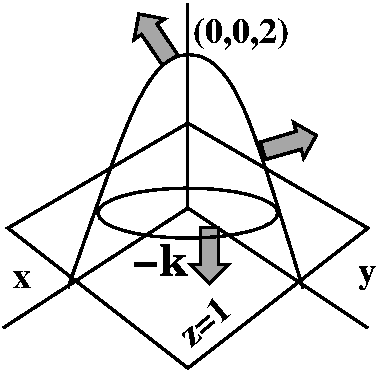
The paraboloid is z=2-x2-y2: it "opens"
down. The vertex or top is at (0,0,2). The normals to the paraboloid
vary a great deal. While it might be possible to compute the flux
directly, the Divergence Theorem states that the integral of 1 (that's
div F) over the solid region above z=1 and below
z=2-x2-y2 will equal the flux through the
parabolic cap plus the flux through the disc on the plane z=1. That
disc has radius 1, centered at the origin, since the boundary is
1=2-x2-y2 or x2+y2=1. Also
the outward normal on the disc is constant because the disc is flat,
and the outward normal is -k.
Let's compute the triple integral: ∫∫∫The cup1 dV. Probably this is
simplest to compute with cylindrical coordinates. θ will go from 0
to 2Π, and r will go from 0 to 1. That's a polar description of the
base of the solid. What's the height? The bottom is at z=1, and the
top is at z=2-x2-y2, or (in "polar")
z=2-r2. So we compute
∫θ=0θ=2Π∫r=0r=1∫z=1z=2-r21 dz r dr dθ=∫θ=0θ=2Π∫r=0r=1(2-r2-1)r dr dθ=
∫θ=0θ=2Π∫r=0r=1(r-r3)dr dθ=
∫θ=0θ=2Π(r2/2-r4/4)]r=0r=0dθ=∫θ=0θ=2Π(1/4)dθ=Π/2.
Now the surface integral over the "bottom" disc. F·n is
(z arctan(y2)i+z3ln(x2+1)j+zk)·(-k) which is -z. But z=1 on this
disc, so we need to integrate -1 over a disc bounded by a circle of
radius 1: the answer is -Π, -1 multiplied by the area of the area.
We now have: Π/2 (the divergence integral) is equal to the flux
over the paraboloid plus -Π (the flux over the disc). Therefore the
flux over the paraboloid must be (3Π)/2.
Other uses
While textbook problems are (sometimes) nice, more interesting uses of
the Divergence Theorem include a discussion of heat transfer
and Gauss's Law for electric charges. We have no time, but I just want
to remark that the results are remarkable and really interesting.
Gauss's Law is discussed in many physics books. Also you can look at
pages 1037 and 1038 of the textbook. The heat equation is discussed in
lots of engineering courses and in several math courses, including
Math 421 which many of the students in this class likely will take.
FTC through the ages ...
I remarked on this at the beginning of the lecture. The three
semesters of calculus are a tour of results from around 1630 or so to
around 1870 or so. We go through, therefore, 250 years of mathematical
development, and certainly this semester, multivariable calculus, has
had its share of really clever ideas. The Fundamental Theorem of
Calculus appeared in the first semester. This semester had a
2-dimensional version (Green's Theorem), a 2.5-dimensional version
(Stokes' Theorem), and even today a 3-dimensional version, the
Divergence Theorem. Wow! And now we are all the way up to the late
Nineteenth Century! Imagine if you took a series of
chemistry or physics or bio courses which would have left you at that
time of the discipline. Just think ...
Thank you for discussing all of this really interesting stuff with me
this semester.

 Proving the Divergence Theorem for the unit cube
Proving the Divergence Theorem for the unit cube Following the suggestion of Mr. Forrest, we looked at
∫∫∫The cube(∂Q/∂y) dV.
We decided to write dV here as dy dAx,z. The
reason for this is that the integration with respect to y will
"undo" the ∂/∂y.
Following the suggestion of Mr. Forrest, we looked at
∫∫∫The cube(∂Q/∂y) dV.
We decided to write dV here as dy dAx,z. The
reason for this is that the integration with respect to y will
"undo" the ∂/∂y.

 ∫x=0x=1(∂P/∂x) dx=P(x,y,z)]x=0x=1=P(1,y,z)-Q(1,y,z).
∫x=0x=1(∂P/∂x) dx=P(x,y,z)]x=0x=1=P(1,y,z)-Q(1,y,z).
